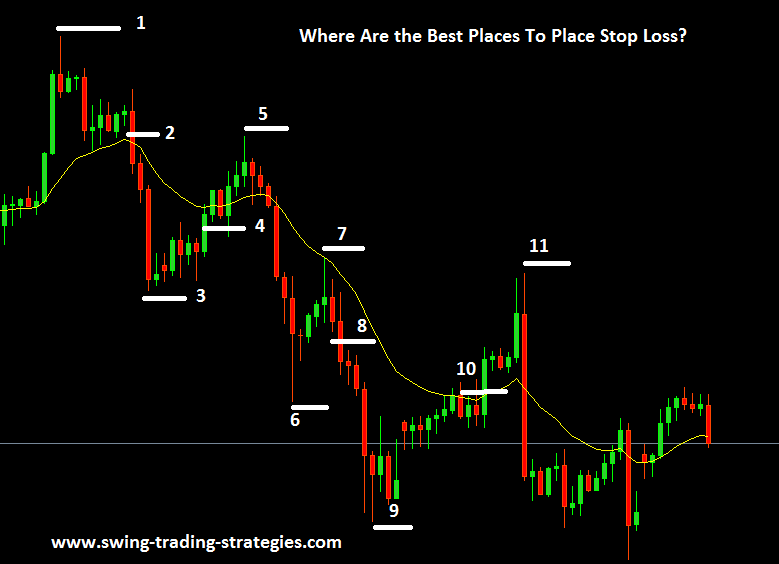Placing a stop loss or at least having a stop loss exit in mind is an important part of risk management. You should always have a place to exit and that will allow you to risk X % of your trading account instead of simply guessing.
Keep in mind that as a person who trades, your first job is risk manager.
You never know if your trade will be a winning trade. Nobody does. In fact, it is quite possible that you will take many loses in a row before the eventual winning trade will come.
So the question is, where should you place your stop?
This chart here is an example of where most traders will place their stops.
- Traders will place their stop loss order just beyond on swing high or low
- Traders will place their stop a set number of pips away from their entry
Both of these methods of setting your stop loss, whether day trading or swing trading, are flawed.
Placing Stops X Pips From Entry Price
Lets be honest, for many of that start trading, we really did not understand that placing a stop loss was that important. Not just placing stop loss but where the stop loss is placed.
You may have been guilty of saying: “I am shooting for 50 pips and I want a 2:1 reward to risk ratio. I will set my stop 25 pips from entry”.
The problem with this kind of technique for placing a stop loss is that it has no reality in the current price movement.
- You could be placing your stop inside the candlestick range that you entered on
- You are setting yourself up to get taken out during the natural evolution and flow of price
- It is not based on the market environment
While this method is better than not placing a stop loss when you enter your trade, you will get frequent stop outs. As well, you can have a reward to risk ratio but that is no guarantee you will ever reach the profit target.
If this is your way of placing a stop loss order, stop doing that right now.
Placing Stops Around Swing Levels
This is a little more logical as it takes into account the way markets move. They ebb and flow. If you enter a long trade, you don’t expect price to go below the support of the swing.
But price can go below the support level even after you enter a trade showing momentum.
To make it worse, many will place their stop X pips under support or X pips above resistance.
This is not a good plan.
When price corrects, it does so with a combination of simple and complex pullbacks. If you enter a trade with a simple pullback, you will be taken out if price continues to form another leg – the complex pullback.
A complex pullback does not mean your trade idea was wrong, just early.
Also keep in mind that you could be entering on a time frame that appears to be finishing its corrective move. The higher time frame may not be and you will be taken out.
A thrust of price above or below a swing level is actually a trade itself: the failure test trade. Using the failure test as an example, if your stop is just below a level and you are taken out and a failure test is in play, you are getting stopped out of a trade with what is a trade entry!
Not the best way to place a stop loss.
Where Is The Best Place For Stop Loss Order?
If you go back to the chart above, beyond the swing levels looks like a good idea. It is a good idea – at the charts point in time and on that time frame.
Keeping in mind that every time frame has it’s own action that gets built into another time frame, you may have entered these candlesticks but on lower time frames. This increases your chances of getting stopped out.
This chart shows a market in an overall uptrend and is pulling back.

If my stop is placed just below the low of the setup candlestick marked with the green star, I’d be taken out just as the market reverses.
Using the Average True Range (setting of 14) and doubling the result, keeps my stop not only out of the way of the average price range, but takes into account sudden volatility increases.
The ATR uses the current state of the market and gives some buffer room to allow a stop placement that makes sense.
It isn’t perfect – nothing in trading ever is.
- Using ATR does not use an arbritary amount of pips or points that does not take into account market conditions
- It does not use structure which ignores that price probes beyond those levels does not invalidate your trading setup
- If you enter a trade before the market has any intention of resuming the move, you may still get stopped out.
Using ATR Uses Market Conditions
If the market is moving with large ranges, your stops will be larger as well which means reduced position sizing which can mean smaller profits.
But remember, our first job is risk manager, not trader.
Our job is to protect our capital. Tight stops will cost you in fees and in the adding up of losses. You will have to re-enter once you see price is still going to go in your desired direction.
Start experimenting with the ATR. I think you will see it is a great objective way to set your stop loss in any market.





 Posted in
Posted in  Tags:
Tags: